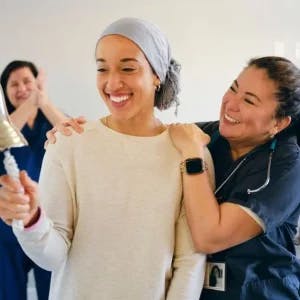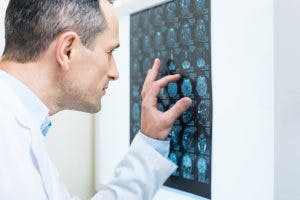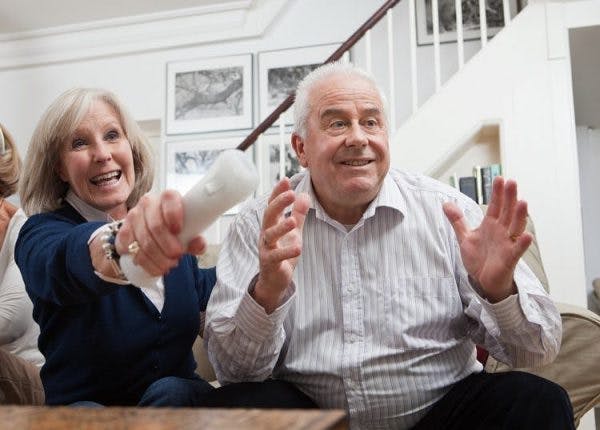Second stroke survival is a topic that many individuals are concerned about after experiencing a stroke. Worries about a second stroke can lead to increased anxiety for survivors due to the widespread secondary effects that can accompany stroke.
The American Stroke Association reports that 1 in 4 survivors will experience a second stroke. While this paints a concerning picture, it is important to note that stroke survival rates continue to improve.
If you’re curious about second stroke survival, we hope this article will have some answers for you. Throughout the article, we will review risk factors, statistics on second stroke survival, and steps you can take to reduce your risk of recurrent stroke.
What Is The Risk of a Second Stroke?
Around 795,000 individuals are affected by stroke each year, according to the CDC. 185,000 of these are individuals who have experienced a previous stroke. Although we know that survival rates are continuously improving, these are still concerning statistics for many survivors.
During the first 3 months of recovery, a survivor’s risk of a second stroke is 15 times higher than the general population, according to Dr. Jodi Edwards. One year later, the risk is reduced, but survivors are still seven times more likely to experience a second stroke. This highlights the importance of following your doctor’s advice about managing your stroke risk factors (which we will discuss soon).
While these first few months are the most unstable, a patient’s risk of a second stroke remains elevated for at least five years. This can cause survivors to experience significant post-stroke anxiety. Fortunately, by taking steps to improve your health, you can help reduce your risk of a second stroke.
Factors that Affect Second Stroke Survival
Even with the advancement of stroke treatment, second strokes are still a very serious matter. This is because strokes are often accompanied by a wide array of secondary effects that can greatly affect a survivor’s daily life. These secondary effects can include hemiplegia or hemiparesis, behavior changes, neuropathy, or difficulty walking after stroke.
This is why practicing stroke prevention strategies is so critical. To reduce the likelihood of a second stroke, it may be helpful to review the factors that increase stroke risk. According to researchers, these risk factors and behaviors include:
- Chronic hypertension
- High cholesterol
- Insufficient physical activity
- Obesity
- Smoking
- Diabetes
- Excessive alcohol use
- A diet high in saturated fats, trans fats, and sodium
Thankfully, many of these risk factors and behaviors can be improved to decrease your risk of a second stroke. Stroke prevention techniques should focus on addressing these problems before they become more serious. In the next section, we will review tips and techniques to decrease the risk of a second stroke for survivors.
Preventing a Second Stroke
While the risk factors we’ve reviewed above increase your risk of a second stroke, these risk factors are largely reversible. By creating new, healthy habits and making positive lifestyle changes, you can improve your health and decrease these risk factors. To help you get started, here are some effective ways to reduce your chances of a second stroke:
1. Quit Smoking
Tobacco contains over 7,000 harmful chemicals, including carbon monoxide. When you inhale cigarette smoke, carbon monoxide and nicotine enter your bloodstream. The carbon monoxide reduces the amount of oxygen in your blood, causing your heart to pump faster to compensate.
This, in turn, raises your blood pressure, which increases your risk of a second stroke. The chemicals in cigarette smoke also make your blood platelets more likely to stick together, narrowing blood vessels and increasing the chances of a blood clot.
In fact, individuals who smoke have a two- to fourfold greater risk of stroke than nonsmokers. These factors make smoking one of the most dangerous activities for stroke patients. Therefore, if you haven’t quit yet, now is the time. The risks are just not worth it. There are many resources available to help you quit smoking and decrease your risk of second stroke.
2. Engage in Cardiovascular Exercise
Exercise is an incredible tool to improve your overall health and reduce the risk of a second stroke. The more active you are, the stronger your heart gets, which means it can pump with less effort. This puts less strain on your arteries and will lower your risk of a second stroke.
The American Stroke Association’s current guidelines highlight exercise recommendations for stroke survivors to reduce second stroke risk. The ASA encourages at least 10 minutes of moderate aerobic exercise four times per week or vigorous exercise for 20 minutes two times per week.
Some examples of cardio activities you can do at your home or in your community include:
- Walks around your neighborhood
- Short bike rides (including stationary cycling)
- Swimming or water aerobics
- Group fitness classes
Mobility impairments after a stroke can make cardio exercises difficult for many survivors. However, exercise is incredibly important, and every exercise matters for survivors to make improvements. Talk with your therapy team to create a rehab plan that is beneficial and accessible for you.
Your physical and occupational therapists can prescribe rehab exercises for all ability levels to help you meet your goals. It is important to keep up with your daily rehab exercises and perform high repetitions to maximize neuroplasticity. As your motor skills improve, you can continue to progress your exercises. This will help you experience the maximum benefits and reduce your risk of a second stroke.
3. Manage Anxiety
Anxiety after stroke is extremely common. Current statistics suggest that around 25% of survivors will experience anxiety in the first five years after stroke. However, living with long-term anxiety can raise your blood pressure and increase your risk of a second stroke.
While anxiety, grief, and frustration can be common experiences for stroke survivors, it is important to take measures to navigate and manage these feelings. Some methods you can use to reduce post-stroke anxiety include:
- Regular exercise
- Limiting caffeine and alcohol
- Meditation and deep breathing
- Psychological care
These methods can help reduce anxiety and decrease your risk of stroke. In addition to exercise and meditation, seeking professional help from a psychologist or other mental health care provider can help. Furthermore, if you continue to struggle with post-stroke anxiety, talk to your doctor about any anti-anxiety medications to address your symptoms.
4. Monitor Your Blood Pressure
High blood pressure is one of the biggest and most controllable risk factors for stroke. Therefore, stroke patients should monitor blood pressure at home, which can be done using an over-the-counter blood pressure cuff.
Keeping a log of your blood pressure will allow you and your doctor to track patterns in your vital signs. This can help your doctor decide if any modifications to your medications are needed.
It is very important to take any medications your doctor has recommended. If you take blood pressure medication, be sure not to miss a dose, and always pick up your next month’s supply before your current bottle runs out. Skipping doses of blood pressure medication is very dangerous and can increase your likelihood of a second stroke.
5. Maintain a Healthy Diet
Working toward eating a healthy diet is a powerful tool for the prevention of a second stroke. It is important to incorporate fresh fruits and vegetables into your meals for healthy vitamins, minerals, and fiber. Also, try to limit foods that are high in trans fats, saturated fats, and cholesterol.
One well-studied example of a healthy diet for stroke prevention is the Mediterranean diet. The Mediterranean diet, which is generally low in cholesterol, has been shown to significantly reduce stroke risk in many studies.
The main components of a Mediterranean diet include:
- Lots of fruits and vegetables
- Whole grains
- Olive oil and other healthy fats
- Fish and poultry
- Beans, lentils, and nuts
- Minimal sugar, butter, or sweets
- Red wine in moderation
These are examples of foods that can boost stroke recovery and reduce the risk of a second stroke for survivors. Additionally, many of these foods help increase BDNF, or brain-derived neurotrophic factor. BDNF is an important protein that our bodies use to create new neural connections. This helps maximize neuroplasticity after stroke, which is how the brain heals and makes new movement pathways.
In addition to positive changes for overall wellness, certain dietary changes can help lower your blood pressure. One easy change you can make is to reduce your salt intake. Consuming too much salt has been linked to stroke, so moderation is key. Be sure to read labels of canned and pre-packaged foods, as these often are very high in sodium.
6. Make Sleep a Priority
Many survivors experience sleep disturbances after stroke due to the disruption of their circadian rhythm and daily routine. In addition to post-stroke fatigue and excessive daytime sleepiness, sleep deprivation can increase the risk of a second stroke.
It is estimated that around 50% of survivors are affected by a sleep disorder after stroke. This can contribute to impaired cognitive function and increases the likelihood that subsequent strokes will take place.
To help improve sleep quality and reduce second stroke risk, take the initiative to create daily habits to improve your sleep quality. Some sleep management tips include following a consistent bedtime routine, creating a dark and relaxing sleep environment, and limiting caffeine before bed. Additionally, performing daily exercise and limiting time spent on electronics can improve sleep quality.
Understanding Second Stroke Survival and Prevention
Second strokes are serious medical emergencies, and the risk of recurrent stroke increases greatly after a survivor’s first stroke. In fact, around 25% of survivors will experience a second stroke. While stroke survival rates are continually improving, prevention is still a crucial part of the recovery process.
Methods to reduce the risk of a second stroke include regular exercise, managing stress and anxiety, and quitting smoking. Additionally, by following a healthy diet such as the Mediterranean diet, you can dramatically reduce your chances of experiencing a second stroke.
Stay consistent with your routine and reach out for help from your doctor or therapy team. Taking steps to reduce the risk of a second stroke is incredibly important and can be accomplished through new, healthy habits. These new habits can help you improve your quality of life and make your recovery a success.















